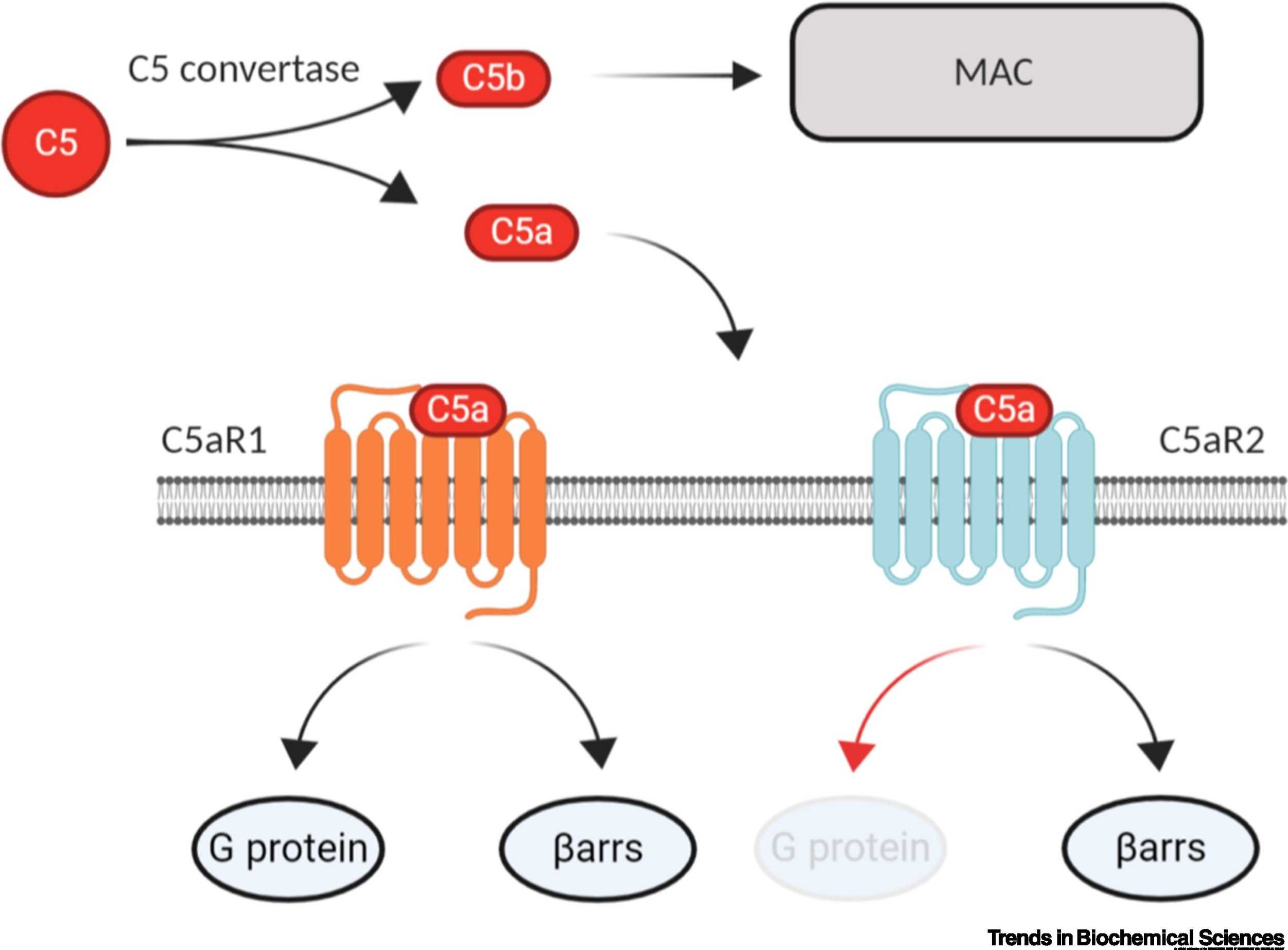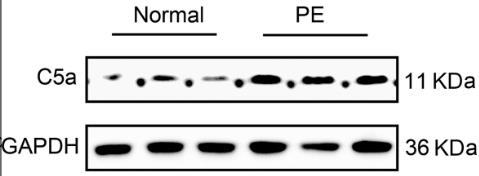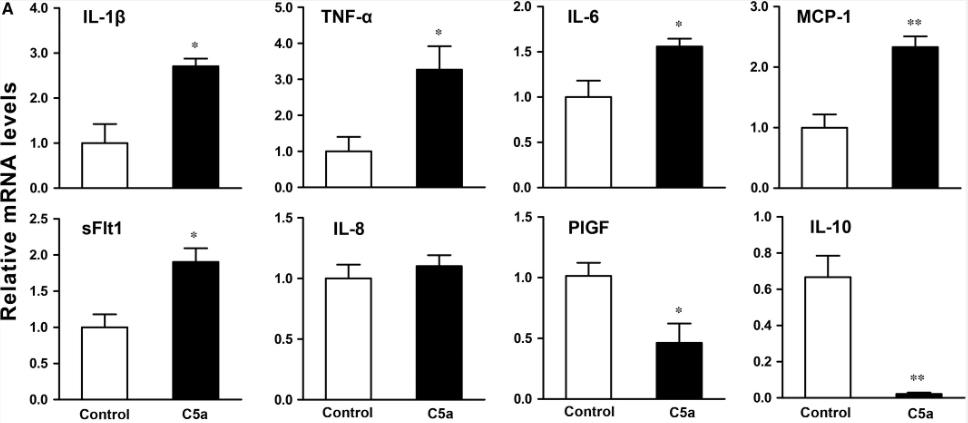C5
-
Official Full Name
complement component 5 -
Overview
The protein encoded by this gene is the fifth component of complement, which plays an important role in inflammatory and cell killing processes. This protein is comprised of alpha and beta polypeptide chains that are linked by a disulfide bridge. An activation peptide, C5a, which is an anaphylatoxin that possesses potent spasmogenic and chemotactic activity, is derived from the alpha polypeptide via cleavage with a convertase. The C5b macromolecular cleavage product can form a complex with the C6 complement component, and this complex is the basis for formation of the membrane attack complex, which includes additional complement components. Mutations in this gene cause complement component 5 deficiency, a disease where patients show a propensity for severe recurrent infections. Defects in this gene have also been linked to a susceptibility to liver fibrosis and to rheumatoid arthritis. [provided by RefSeq, Jul 2008] -
Synonyms
C5;complement component 5;C5D;C5a;C5b;ECLZB;CPAMD4;complement C5;prepro-C5;C5a anaphylatoxin;anaphylatoxin C5a analog;C3 and PZP-like alpha-2-macroglobulin domain-containing protein 4
Recombinant Proteins
- Human
- Cynomolgus
- Rat
- Mouse
- Pig
- E.coli
- Human Serum
- Wheat Germ
- HEK293
- Yeast
- Human Plasma
- Mouse
- Non
- His
- GST
- Fc
- SUMO
- Myc
- Flag
Background

Fig1. Schematic Representation of Two Complement C5a Receptors (C5aRs) and Their Transducer Coupling. (Shubhi Pandey, 2020)
What is C5 protein?
C5 gene (complement C5) is a protein coding gene which situated on the long arm of chromosome 9 at locus 9q33. This gene encodes a component of the complement system, a part of the innate immune system that plays an important role in inflammation, host homeostasis, and host defense against pathogens. The encoded preproprotein is proteolytically processed to generate multiple protein products, including the C5 alpha chain, C5 beta chain, C5a anaphylatoxin and C5b. The C5 protein is comprised of the C5 alpha and beta chains, which are linked by a disulfide bridge. Cleavage of the alpha chain by a convertase enzyme results in the formation of the C5a anaphylatoxin, which possesses potent spasmogenic and chemotactic activity, and the C5b macromolecular cleavage product, a subunit of the membrane attack complex (MAC). The C5 protein is consisted of 1676 amino acids and C5 molecular weight is approximately 188.3 kDa.
What is the function of C5 protein?
The C5 protein plays a vital role in the immune system as part of the complement system, which is a series of proteins that work together to clear pathogens and damaged cells. When activated, C5 is cleaved into two fragments, C5a and C5b. C5a acts as an anaphylatoxin and chemoattractant, triggering inflammatory responses and attracting immune cells to the site of infection. Meanwhile, C5b initiates the formation of the membrane attack complex (C5b-9), which can destroy pathogens by forming pores in their cell membranes. Dysregulation of C5 activation is associated with various diseases, including inflammatory and autoimmune conditions, and targeting C5 or its products is an area of active therapeutic research.
C5 related signaling pathway
The C5 protein is a critical component of the complement system, which is part of the immune response. When C5 is activated, it is cleaved into C5a and C5b fragments. C5a acts as a proinflammatory mediator, binding to the C5a receptor (C5aR) to trigger a variety of cellular responses such as chemotaxis and cytokine release, which are important for recruiting immune cells to the site of infection or tissue damage. The C5b fragment initiates the formation of the membrane attack complex (MAC), which can create pores in the membrane of pathogens, leading to their destruction. Dysregulation of C5 activation can contribute to inflammatory and autoimmune diseases, and targeting C5 or its products is an area of active therapeutic research.
C5 related diseases
The C5 protein is a component of the complement system, which is a part of the immune system. It plays a critical role in the inflammatory response and host defense. When activated, C5 is cleaved into C5a and C5b. C5a acts as an anaphylatoxin and chemoattractant, triggering inflammation and attracting immune cells to the site of infection. Meanwhile, C5b initiates the formation of the membrane attack complex (MAC), which can destroy pathogens by puncturing their cell membranes. Dysregulation of C5 is associated with various diseases, including paroxysmal nocturnal hemoglobinuria (PNH), atypical hemolytic uremic syndrome (aHUS), and neurodegenerative disorders like Alzheimer's disease.
Bioapplications of C5
The C5 protein plays a significant role in the complement system's bioapplications, particularly in therapeutic approaches. It is the target of several monoclonal antibodies and modulators that have been developed to treat diseases like paroxysmal nocturnal hemoglobinuria (PNH) and atypical hemolytic uremic syndrome (aHUS). C5 inhibition is also being explored as a potential treatment for peripheral neuropathies, inflammatory diseases, and even certain types of cancer. For instance, eculizumab, a C5-targeting antibody, is used to treat PNH and aHUS, and biosimilars of eculizumab are in late-stage clinical trials for these conditions. Other C5 inhibitors, such as ravulizumab and avacincaptad pegol, are being tested for various applications, including neuromyelitis optica spectrum disorder (NMOSD) and age-related macular degeneration (AMD). Furthermore, C5a receptor antagonists like avacopan are being investigated for the treatment of ANCA-associated vasculitis, indicating the broad potential of C5-related therapies in clinical medicine.
Case Study
Case Study 1: Keith Jendza, 2019
The complement system is a crucial immune function, and its overactivation is linked to various diseases. Human complement component 5 (C5) is a proven therapeutic target, with the anti-C5 antibody Soliris approved for treating paroxysmal nocturnal hemoglobinuria. Researchers now introduce the discovery, optimization, and action mechanism of a novel small-molecule C5 inhibitor.

Fig1. α-Chymotrypsin sensitivity of full-length C5 protein with compounds.

Fig2. Correlation between direct binding to C5 protein (DSF shift assay) and complement inhibition (2% human serum assay) for the 13 compounds in the article.
Case Study 2: Yu Ma, 2018
Pre-eclampsia (PE) is a severe disorder affecting both mother and child. Recent findings suggest a role for complement system activation in PE's pathology, particularly involving complement 5a (C5a). This study indicates that C5a is crucial in abnormal placentation, a key initiator of PE. The increased C5a in macrophages and higher C5a receptor (C5aR) levels in trophoblasts from pre-eclamptic placentas. C5a promotes an anti-angiogenic phenotype in trophoblasts by disrupting the balance of factors like sFlt1 and PIGF, and it inhibits their migration and tube formation, which is reversible with C5aR knockdown. Additionally, we observed higher maternal C5a serum levels in PE, correlating with blood pressure and arterial stiffness.

Fig3. Western blot of C5a protein expression in placentas of two groups.

Fig4. HTR-8/SVneo cells treated with C5a showed a polarization towards an anti-angiogenic phenotype with significantly increased mRNA levels.
Quality Guarantee
High Purity
.jpg)
Fig1. SDS-PAGE (C5-562H)
.
.jpg)
Fig2. SDS-PAGE (C5-0077H)
Involved Pathway
C5 involved in several pathways and played different roles in them. We selected most pathways C5 participated on our site, such as Complement and coagulation cascades,Prion diseases,Pertussis, which may be useful for your reference. Also, other proteins which involved in the same pathway with C5 were listed below. Creative BioMart supplied nearly all the proteins listed, you can search them on our site.
| Pathway Name | Pathway Related Protein |
|---|---|
| Herpes simplex infection | ABCB3L1,EEF1DA,OAS3,Fasl,MAPK8A,HLA-DOA,SRSF3,HLA-DQA1,CLOCKA,SRSF1 |
| Prion diseases | NCAM2,HSPA1A,IL1A,NCAM1,MAP2K2,IL6,SOD1,PRKACG,C1QB,C7 |
| Pertussis | Hc,CFL2,MAPK12,PYCARD,MAPK1,GM5077,SERPING1,MAPK9,C1QB,C1RA |
| Staphylococcus aureus infection | CFI,FCGR3A,H2-AB1,HLA-DRA,FCGR3,HLA-DQA2,HLA-DPB1,FCGR4,FCGR2A,HLA-DRB3 |
| Complement and coagulation cascades | C4A,F8,PLAU,F11,CFD,SERPINA1D,C6,F12,C8G,A2M |
| Systemic lupus erythematosus | HIST2H2AC,HIST1H4M,GRIN2B,HIST1H2AH,HIST2H4,TROVE2,HIST1H2BQ,HIST1H2AO,FCGR4,HIST1H4C |
Protein Function
C5 has several biochemical functions, for example, chemokine activity,endopeptidase inhibitor activity,protein binding. Some of the functions are cooperated with other proteins, some of the functions could acted by C5 itself. We selected most functions C5 had, and list some proteins which have the same functions with C5. You can find most of the proteins on our site.
| Function | Related Protein |
|---|---|
| endopeptidase inhibitor activity | PROS1,PCSK1N,UCHL5,Serpina1b,C3,Hc,STFA1,CAST,USP14,CST14B.1 |
| chemokine activity | CCL7,CCL20A.3,CXCL8B.3,CCL35.1,CXCL12,CCL19A.2,CCL25,CCL11,CCL27B,AMCF-II |
| receptor binding | NMU,PTK2AB,TNFSF12,NPPC,MATK,CSK,CADM2,TYROBP,PARK7,PPP2R4 |
| protein binding | RPN1,CNTF,NANOS2,RAB26,MCEE,ID2,HAPLN2,KCNA4,SF1,ATF6 |
Interacting Protein
C5 has direct interactions with proteins and molecules. Those interactions were detected by several methods such as yeast two hybrid, co-IP, pull-down and so on. We selected proteins and molecules interacted with C5 here. Most of them are supplied by our site. Hope this information will be useful for your research of C5.
CREB3L1;vco3_najka;d3jib2_staau
Resources
Research Area
Related Services
Related Products
References
- Hallstensen, RF; Bergseth, G; et al. Eculizumab treatment during pregnancy does not affect the complement system activity of the newborn. IMMUNOBIOLOGY 220:452-459(2015).
- Ohta, T; Urayama, K; et al. Eculizumab in the treatment of atypical hemolytic uremic syndrome in an infant leads to cessation of peritoneal dialysis and improvement of severe hypertension. PEDIATRIC NEPHROLOGY 30:603-608(2015).



